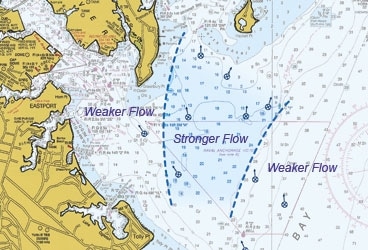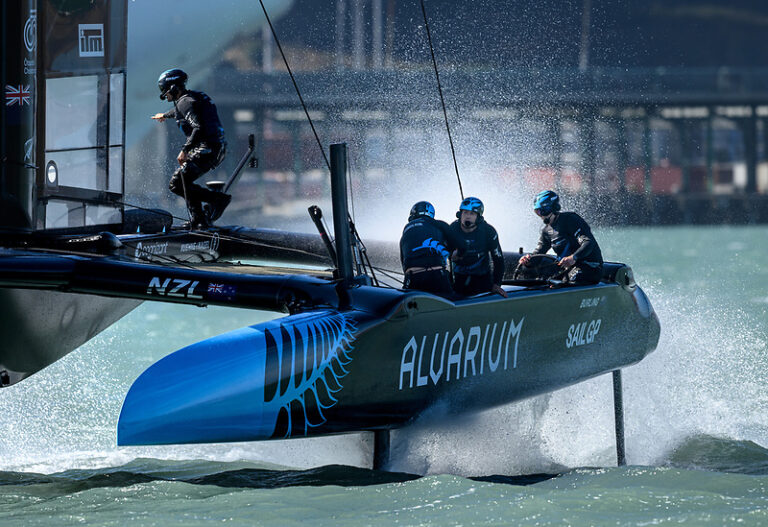
local knowledge 368
“Local knowledge” is a wonderful thing, but its value depends on whether someone is willing to provide it and whether that someone knows what they’re talking about. I was the first American to win the International 14 Prince of Wales Cup because I asked the local fishermen about the strong, parallel-to-shore tidal currents. They knew the best way to avoid the strong southerly tidal current in a northerly was to tack up the beach, in and out of the protruding “groins.”
When, in the ’50s, ’60s, and ’70s, I was asked by visitors to Annapolis how to handle the north-going flood in a southerly, I told them to go right and stay inshore until they reached the starboard layline. I was willing to talk, but I didn’t know what I was talking about at the time. I realized this about 15 years ago when Dave Curtis beat me to the weather mark.
I had tacked to port immediately after starting and led most of the fleet inshore, while Dave, leading the rest, held starboard at least halfway to the port layline before tacking. I was confident that inshore, in shallower water and less adverse current, I would pull out on his leebow and beat him easily. Instead, in the dying southerly, he gradually pulled abeam and rounded the mark 200 yards ahead. Afterwards he told me that he was convinced the adverse current had been weaker farther offshore. I scoffed at the idea, and assured him that, due to increasing friction, the Chesapeake Bay’s north-south current always becomes progressively weaker as one moves inshore from the deep Bay into shallower water.
However, after a few others beat me on other similar occasions, I realized I needed to check my supposed local knowledge. I recognized that the Chesapeake’s complicated underwater contours and multiple and sizeable indentations could deflect the tidal currents into odd patterns of flow. I remembered my experience in San Francisco Bay before the Olympic Trials of 1972. I’d distrusted the presumptions about the currents on the Berkeley Circle and spent several days with a current stick determining current strength and direction at every hour at each of the fixed marks of the circle. I was surprised to find that in the shallow water of the racing area the flow developed a circular eddy different from the implications of the local knowledge and the touted hydrological model.
The most important consequence of current is that, when it differs in strength across the course, it is possible for boats to sail in areas of differing strength. Because adverse current prolongs the duration of exposure, the most important strategic requirement when racing in adverse current is to discover and sail in an area of lessened strength. Current produces three other important effects: it moves the boat referrable to the fixed marks of the course (which effects starting tactics, laylines, sailing angles, and mark roundings); it alters the duration of legs (thereby exaggerating or diminishing the effects of performance differences); and, if it is not recognized and properly managed, it may alter apparent-wind strength and boatspeed on runs. But recognizing differences in its strength and utilizing that knowledge is by far the most important.
In tidal waters, current is often the most important aspect of local knowledge as it operates every day and is more predictable than local winds, and is less effected by variations in the weather. When a racing sailor seeks knowledge about the local current, his first question should be: Does it vary across the course? His second question should be: How strong does it get? The third: When and where in each tidal cycle is it strongest and weakest? Unless you find someone who has personally checked the racing area, the answers you receive may not be correct. And, of course, in order to utilize the information you receive and to apply it to the time you are racing, you need to determine (from the published Current Tables or by applying offsets to the Tide Tables) when Ebb Begins (EB) and when Flood Begins (FB).
When I decided to unravel the current behavior in our Annapolis racing area, I asked for help from my friend Bob Putnam-who owned the necessary tool, a powerboat. Bob and I anchored a number of buoys which, together with several government marks and crab pot buoys, established a 12-mark grid within and around the racing area. Over a three-day period we circled the grid, dropped our current stick, and measured its speed and direction of displacement from each of those marks during every hour of the tidal cycle.
I recognized the study would only reflect the current’s timing and strength on the days of testing and that on other days these factors would vary with the differing positions of the moon and the sun, with barometric pressure, and with wind flow in the Chesapeake Bay where the tide is higher and the current stronger in southerlies that push ocean water into the Bay and lower and weaker in northerlies that push water out of the Bay. But a few days of testing throughout an entire tidal cycle (12.5 hours at Annapolis) uncovered relative differences in the strength and direction of flow at particular sites within the racing area-the information most important to the racer.
We discovered a number of significant, but previously unrecognized, manifestations: the pattern of flow in the ebb was quite different from the pattern in the flood-not a mere reversal of flow; the strength of surface flow was not proportional to the depth (as, due to friction affecting the bottom layer, it usually is in tidal waters); the change from ebb to flood (and vice versa) was neither, as is usual, an abrupt reversal of direction nor a gradual increase in strength.
We discovered the ebb begins inshore and offshore simultaneously, but that inshore it increases in strength rapidly to near maximum 1 to 2 hours after EB and that offshore it increases slowly to maximum 3 to 5 hours after EB. Not surprisingly we found that the ebb was but one-half to one-third as strong over the near-shore center of the racing area as it was between the 25-foot and 30-foot depth lines offshore. But we were amazed to find that the flow was stronger along that underwater bank at the outer edge of our racing area than it was in mid-Bay, and that the strongest flow of all was over the shoal on the northeast edge of the course area! Apparently the shoals protruding offshore from Hackett’s Point diminish the width and depth of the Bay, constrict the mass of water ebbing south from the northern Bay, and (acting like the shallows of a river) accelerate rather than retard the surface flow.
We discovered the flood begins inshore flowing east an hour before official FB, but is not evident on the ships anchored in mid-Bay until 1.5 to 2 hours after FB. Flood begins in the racing area at FB, flowing strongly west along the 30-foot depth line and northwest in the Annapolis Channel. Not until 3 hours after FB does the flow turn north along the 30-foot depth line and thereafter it weakens progressively. To my great surprise, from 3 to 6 hours after FB, we found that the flow was stronger inshore of the center of the course area (flowing north, in the approaches to the Whitehall Channel and northeast near Hackett’s Point) than it was offshore of the center of the course area (over the 25-foot line and farther offshore).
The flood, like the ebb, was behaving as if it were flowing in a river. As the flood traversed the progressively lessening depths to fill Whitehall Bay and its many tributaries, it accelerated and from 3 to 6 hours after FB, was moving to the north on the inshore half of the racing area twice as fast as the water in the deep, wide Bay. Dave Curtis had been right, from 3 to 6 hours after Flood Begins one should go offshore, not inshore, to escape the worst of the adverse current!
One wonders how much other local knowledge in other tidal venues is based on similar false presumptions and begs to be corroborated or refuted by days of testing with a current stick-and whether I’ll have time to test them all!
Ask the right questions
When a racing sailor seeks knowledge about local current he should ask:
1. Does it vary across the course?
2. How strong does it get?
3. When and where in each tidal cycle is it









